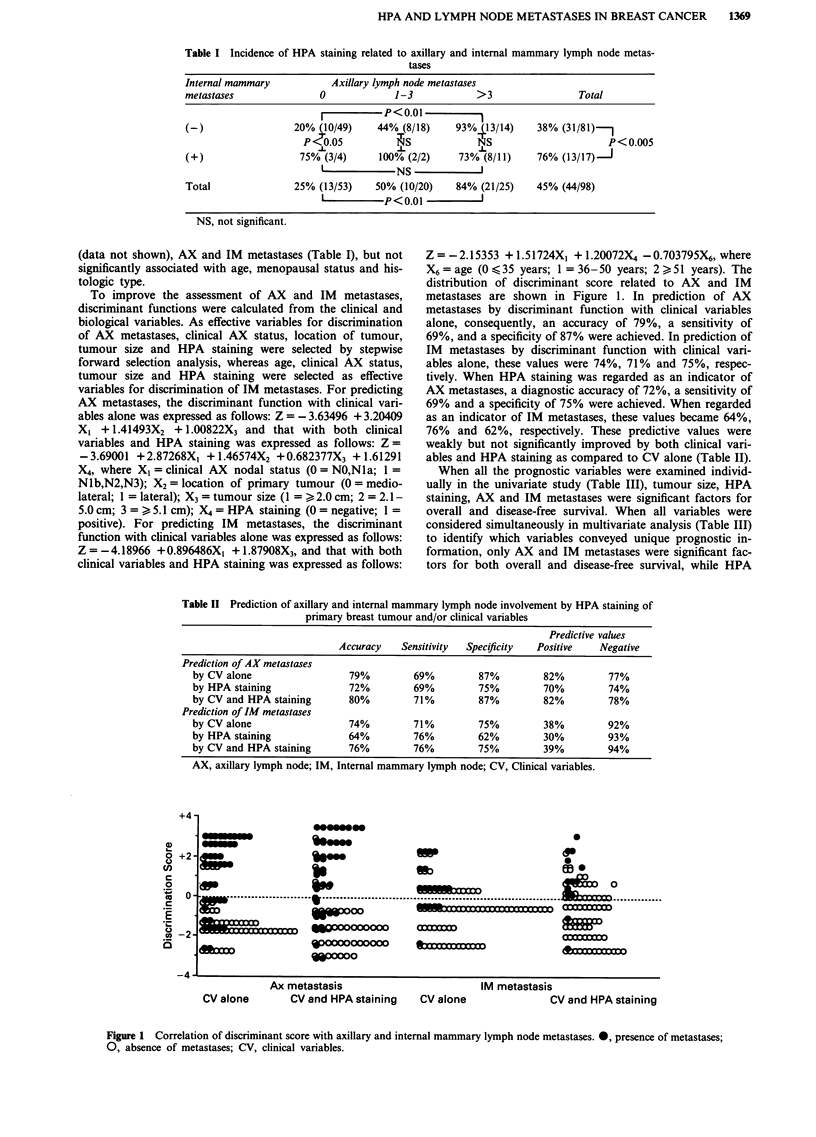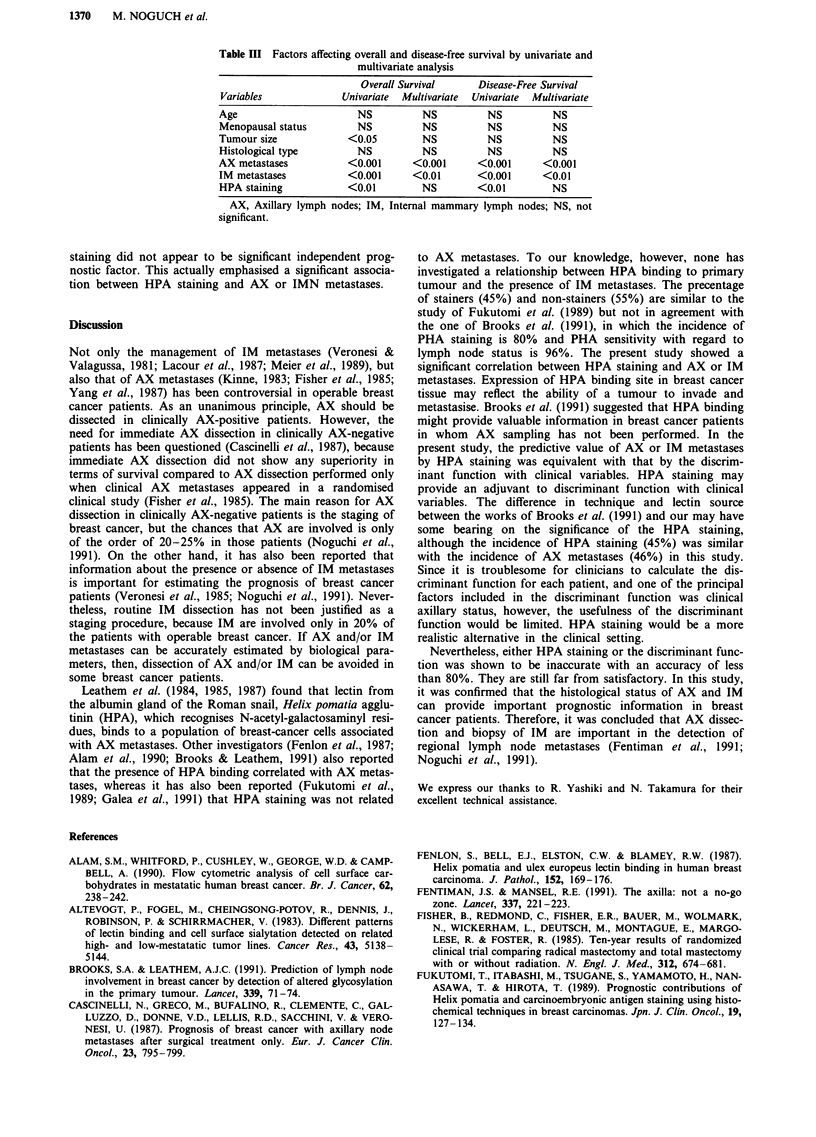Abstract
We investigated the relation between Helix pomatia (HPA) staining of primary breast cancer and the presence of axillary (AX) or internal mammary (IM) metastases, and evaluated its predictive value for AX or IM metastases in comparison with the use of clinical variables. There was a significant association between the HPA staining and AX or IM metastases. When HPA staining was regarded as an indicator of AX metastases, a diagnostic accuracy of 72%, a sensitivity of 69% and a specificity of 75% were achieved. As an indicator of IM metastases, these values were 64%, 76% and 62%, respectively. In predicting the presence of AX metastases using a discriminant function with clinical AX status, location of tumour and tumour size, diagnostic accuracy, sensitivity and specificity were 79%, 69% and 87%, respectively. In predicting the presence of IM metastases using the discriminant function with clinical AX status and tumour size, these values were 74%, 71% and 75%, respectively. Therefore, it was concluded that the HPA staining may be useful, but it was equivalent with the discriminant function with clinical variables in prediction of AX or IM metastases.
Full text
PDF



Selected References
These references are in PubMed. This may not be the complete list of references from this article.
- Alam S. M., Whitford P., Cushley W., George W. D., Campbell A. M. Flow cytometric analysis of cell surface carbohydrates in metastatic human breast cancer. Br J Cancer. 1990 Aug;62(2):238–242. doi: 10.1038/bjc.1990.267. [DOI] [PMC free article] [PubMed] [Google Scholar]
- Altevogt P., Fogel M., Cheingsong-Popov R., Dennis J., Robinson P., Schirrmacher V. Different patterns of lectin binding and cell surface sialylation detected on related high- and low-metastatic tumor lines. Cancer Res. 1983 Nov;43(11):5138–5144. [PubMed] [Google Scholar]
- Brooks S. A., Leathem A. J. Prediction of lymph node involvement in breast cancer by detection of altered glycosylation in the primary tumour. Lancet. 1991 Jul 13;338(8759):71–74. doi: 10.1016/0140-6736(91)90071-v. [DOI] [PubMed] [Google Scholar]
- Cascinelli N., Greco M., Bufalino R., Clemente C., Galluzzo D., delle Donne V., de Lellis R., Sacchini V., Veronesi U. Prognosis of breast cancer with axillary node metastases after surgical treatment only. Eur J Cancer Clin Oncol. 1987 Jun;23(6):795–799. doi: 10.1016/0277-5379(87)90281-1. [DOI] [PubMed] [Google Scholar]
- Fenlon S., Ellis I. O., Bell J., Todd J. H., Elston C. W., Blamey R. W. Helix pomatia and Ulex europeus lectin binding in human breast carcinoma. J Pathol. 1987 Jul;152(3):169–176. doi: 10.1002/path.1711520305. [DOI] [PubMed] [Google Scholar]
- Fentiman I. S., Mansel R. E. The axilla: not a no-go zone. Lancet. 1991 Jan 26;337(8735):221–223. doi: 10.1016/0140-6736(91)92172-x. [DOI] [PubMed] [Google Scholar]
- Fisher B., Redmond C., Fisher E. R., Bauer M., Wolmark N., Wickerham D. L., Deutsch M., Montague E., Margolese R., Foster R. Ten-year results of a randomized clinical trial comparing radical mastectomy and total mastectomy with or without radiation. N Engl J Med. 1985 Mar 14;312(11):674–681. doi: 10.1056/NEJM198503143121102. [DOI] [PubMed] [Google Scholar]
- Fukutomi T., Itabashi M., Tsugane S., Yamamoto H., Nanasawa T., Hirota T. Prognostic contributions of Helix pomatia and carcinoembryonic antigen staining using histochemical techniques in breast carcinomas. Jpn J Clin Oncol. 1989 Jun;19(2):127–134. [PubMed] [Google Scholar]
- Kinne D. W. Surgical management of primary breast cancer. Cancer. 1983 Jun 15;51(12 Suppl):2540–2546. doi: 10.1002/1097-0142(19830615)51:12+<2540::aid-cncr2820511327>3.0.co;2-n. [DOI] [PubMed] [Google Scholar]
- Lacour J., Lê M. G., Hill C., Kramar A., Contesso G., Sarrazin D. Is it useful to remove internal mammary nodes in operable breast cancer? Eur J Surg Oncol. 1987 Aug;13(4):309–314. [PubMed] [Google Scholar]
- Leathem A. J., Brooks S. A. Predictive value of lectin binding on breast-cancer recurrence and survival. Lancet. 1987 May 9;1(8541):1054–1056. doi: 10.1016/s0140-6736(87)90482-x. [DOI] [PubMed] [Google Scholar]
- Meier P., Ferguson D. J., Karrison T. A controlled trial of extended radical versus radical mastectomy. Ten-year results. Cancer. 1989 Jan 1;63(1):188–195. doi: 10.1002/1097-0142(19890101)63:1<188::aid-cncr2820630130>3.0.co;2-m. [DOI] [PubMed] [Google Scholar]
- Noguchi M., Ohta N., Koyasaki N., Taniya T., Miyazaki I., Mizukami Y. Reappraisal of internal mammary node metastases as a prognostic factor in patients with breast cancer. Cancer. 1991 Nov 1;68(9):1918–1925. doi: 10.1002/1097-0142(19911101)68:9<1918::aid-cncr2820680913>3.0.co;2-l. [DOI] [PubMed] [Google Scholar]
- Prediction of lymph node involvement in breast cancer. Lancet. 1991 Aug 10;338(8763):392–393. [PubMed] [Google Scholar]
- Steck P. A., Nicolson G. L. Cell surface glycoproteins of 13762NF mammary adenocarcinoma clones of differing metastatic potentials. Exp Cell Res. 1983 Sep;147(2):255–267. doi: 10.1016/0014-4827(83)90208-2. [DOI] [PubMed] [Google Scholar]
- Veronesi U., Cascinelli N., Greco M., Bufalino R., Morabito A., Galluzzo D., Conti R., De Lellis R., Delle Donne V., Piotti P. Prognosis of breast cancer patients after mastectomy and dissection of internal mammary nodes. Ann Surg. 1985 Dec;202(6):702–707. doi: 10.1097/00000658-198512000-00007. [DOI] [PMC free article] [PubMed] [Google Scholar]
- Veronesi U., Valagussa P. Inefficacy of internal mammary nodes dissection in breast cancer surgery. Cancer. 1981 Jan 1;47(1):170–175. doi: 10.1002/1097-0142(19810101)47:1<170::aid-cncr2820470128>3.0.co;2-c. [DOI] [PubMed] [Google Scholar]
- Yang J. H., Slack N. H., Nemoto T. Effect of axillary nodal status on the long-term survival following mastectomy for breast carcinoma: nodal metastases may not always suggest systemic disease. J Surg Oncol. 1987 Dec;36(4):243–248. doi: 10.1002/jso.2930360406. [DOI] [PubMed] [Google Scholar]


